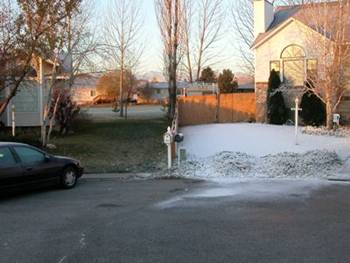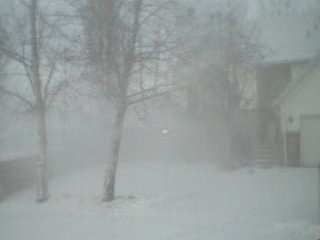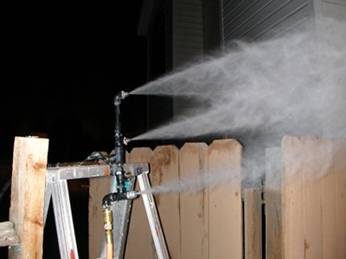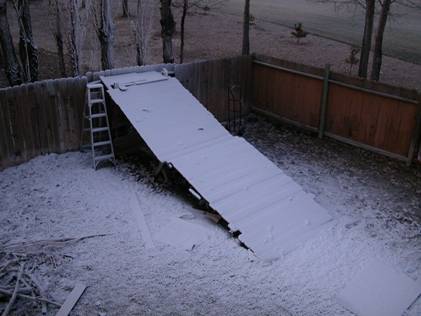D.I.Y. Snow; Backyard Ski Resort
D.I.Y. Snow
By Gregg Blanchard of Second Nature Snowmaking
Published November 2006

Few if any snow riders have failed to notice the many snowmaking machines that line the trails of their favorite ski area. When snowmaking was first introduced more than fifty years ago, it was as much a novelty as it was useful to the trails. As the demand for efficient snowmaking machines increased so did the companies that produced them. Technology developed, snowmakers became more affordable and ski areas all over the world began to make snow in order to open earlier and help keep high traffic zones covered. Now snowmaking begins in October at many resorts and continues till spring in order to provide seasons that stretch over six or more months!
When snowboarding burst on the winter sports scene, snowmaking adopted a new role. Terrain parks demanded huge amounts of snow, and snowmakers were moved from high traffic areas to the parks in order to build half pipes and kickers. Soon entire resorts were dedicated solely to jumps and jibs and snowmaking became even more essential. Most years Bear Mountain California, Killington Vermont, and many others open trails which are covered almost exclusively by man made snow.
But snowboarding fashion changes and within a few years pre-season riders went from building kickers to sliding rails. Most terrain parks filled in the space along the sides of the tabletops with fun boxes, and snowboarding films began to show more jib shots than jump shots.

Since riding a rail took a lot less snow than making a jump, snowboarders began to construct rails anywhere that had snow. Even if the local hill got just a few inches it was more than enough to set up a rail on. However, one frustrating problem kept coming up: there wasn’t always snow, even in the dead of winter! This held especially true in many areas in the Midwestern and Eastern parts of the United States where, despite the bitter cold of winter, snow just never seemed to fall. All at once snowmaking took on a whole new face as it moved from the huge ski resorts to the back yard.
Two of the first recorded home snowmakers were the Herishko brothers in New York. Setting up base on a small “mountain” on their family’s farm, they began making snow on a much smaller scale than was ever imagined by their neighbors at Hunter Mountain. Polar Peak, as they called it, was even equipped with a rope tow which transformed their mountain into a private ski area. This was only the first step in home snowmaking though because in their snowy footsteps followed Eric and Leo Constantino whose small scale home snowmaker gave them a white thanksgiving and eventually a white Christmas, which left their snow-less neighbors drooling.
Just like snowmaking at the resorts, for the most part, home snowmaking was first used as a novelty. Families would fill their yards with snow just so they could make snowmen and have their Christmas holidays white instead of brown. However, the desire of snowboarders to be able to jib and jump as much as possible, blended with the up and coming home snowmaking scene led to the birth of the backyard terrain park.
So how do you actually make snow? Let’s cover some basics; though the process is artificial, the product is real snow, plain and simple. Compressed air is used to break apart water into extremely small particles, and then as the air expands it cools the water and freezes those tiny drops to form snow. It needs to be below 28F (-2C) outside in order to make snow, which is common for many parts of the United States during the winter. Commercial ski resorts use many thousands of cubic feet of compressed air every minute, but most home snowmakers will use only about 7 or 8 cubic feet of air every minute, which is more than enough to cover an entire yard with snow in a matter of hours.

A simple ramp made from picnic tables, old planks, or even the stairs coming down off the deck in the backyard become a perfect run-in for a rail, box, or wall-ride. With a good snowgun at your side you can cover the ramp with many inches of snow in just hours!
Man made snow actually lasts longer than Mother Nature’s, because it is denser, so it will stick around even when it warms up during the day. Also, when it does begin to melt, the run-off will tend to drain through the snow instead of turning the whole thing to unrideable slush like natural snow ends up on hot days.
Just picture it; it’s early November, the local hill hasn’t opened yet and won’t make snow despite a big cold front coming in because two days later it will be back up in the 60s (15C). The low temperature is going to be 25F (-4C) according to the local weatherman. You wait anxiously by the thermometer as it slowly drops past 30F (-1C), past 28F (-2C), and finally at 27F (-3C) you fire up your snowgun on a small hill in your back yard.

A couple of hours later you have a few inches on your hill and you setup a small box as you let the snowgun continue to blow out snow. You and your buddies slide the box all morning and through the day and then make more snow the next night so by the time its all said and done you have a foot of snow all over the hill and you slide your rails for days after.
Home snowmaking has become the perfect way for snowboarders all over the world to live the “board at home” dream. Instead of wondering why the snow isn’t falling despite the fact that it’s freezing outside, you can simply say, “Forget Mother Nature, I am taking control!” So grab your air compressors, grab your boards and snow skates and let’s make some snow!
For more information on how to guarantee a white Christmas, check out Gregg Blanchard’s snow making company Second Nature Snowmaking.




























